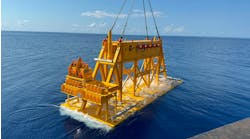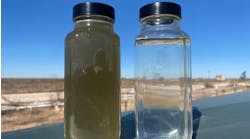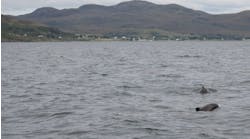20-year head start has competition scrambling
William Furlow
Technology Editor
The Transocean Amirante is breaking new ground in the offshore Trinidad theater drilling the first deepwater well in 1,800 ft of water, in Block 5a.
Amoco has known about the gas fields off Trinidad for more than 20 years, but the reserves remained in the ground because Amoco's primary business was oil production and the company did not see any natural synergies that would justify this production. Also, in the part there was not an active, thriving market for the gas Amoco discovered.
Fast forward to 1996. Amoco and the Trinidad government began discussing the development of the Atlantic LNG plant on the country's Atlantic coast on 120 acres of land in a town called Point Fortin. Once on line, this plant would be a significant driver for the development of an export market. The plans and approvals required for the start up of construction of the plant is a tribute to the vision and progressive policies of the Government of Trinidad and Tobago. LNG train 1 is expected to come onstream by the second quarter of 1999 with an annual production capacity of 3 MMt. This plant should go from concept to first production in only six and a half years which is far below the world-wide average of 14 years for similar projects.
Meanwhile, more large natural gas discoveries are being made in relatively shallow water. This a good signal for Amoco Energy and Trinidad and Tobago because it will support the growing domestic demand for natural gas. Trinidad currently has six world scale ammonia plants, four methanol plants and a fifth under construction. In addition, there are facilities for the production of urea, steel, direct reduced iron and iron carbide, and the processing of natural gas liquids.
Expanding consumption
To secure the loans needed to explore for gas, Amoco first had to prove there could be a strong domestic market. Amoco Exploration Manager Mike Cole said this required a balanced approach between export and domestic sales.This strategy has paid off by developing a domestic market of 700 MMcf/d Cole said he estimates this existing market could grow by an additional 250 MMcf/d. With the addition of other domestic projects, Trinidad could see a domestic market with demand as high as 2 Bcf/d.
Further growth is projected over the long term, and would require a full three trains of LNG from the new plant. But even at these levels, Amoco has identified enough gas reserves to supply the market for 50 years. In an attempt to effectively use the available and growing natural gas resourses Amoco has formed an alliance with Repsol to market the liquefied natural gas that will be produced by the three trains, primarily to Spain. To keep up with this expansion plan, Amoco will drill 6-8 exploration wells each year. This program is designed in the hope of discovering gas reserves equal to the 3.8 Tcf the company discovered last year. Cole said he believes it is reasonable to expect similar finds for the next 3-4 years.
Other participants
News of Amoco's success and the innovative business style of the government towards the development of the energy sector has spread through the industry and other majors are beginning to move in. The Trinidad government is revamping its standing lease agreement to take advantage of this new exploration and the promise of production.Enron and British Gas are also suppliers to this plant. British Gas operates the Dolphin gas field in Block 6b, on behalf of a 50-50 BG/Texaco partnership. The field entered production in March of 1996 and will supply up to 275 MMcf/d to the National Gas Company of Trinidad and Tobago under a 20-year supply contract.
Reserves are estimated at 1 Tcf. BG/Texaco are also partners in a production sharing contract for the Dolphin Block 5a with an initial exploration phase of 4 years. This exploration includes the drilling of two exploration wells and acquisition of 350 sq km of 3D seismic.
In July, Enron Oil & Gas (EOG) announced it had made the biggest gas discovery in the company's history in the Omega field off Trinidad. According to EOG, the Omega discovery is expected to contain gross 600 Bcf of gas. Additional reserve potential is present in multiple prospects in the block and will be delineated over time. BG is also a 26% partner in the Atlantic LNG plant. According to Enron reports, EOG produced 113 MMcf/d of natural gas and 3,400 b/d of crude in Trinidad last year.
Oil discoveries
Amoco Energy in January announced a major oil discovery in the Immortelle Field 35 miles offshore and south-east of its operations headquarters at Galeota Point, in Trinidad. This discovery was made while confirming natural gas reserves in the Immortelle No. 9 well. The oil zones are in the Immortelle's 22 sand at 9,300 ft with a 46 ft oil column and the Immortelle 21 sand, at 8,615 ft with an oil column of approximately 90 ft. The recoverable reserves from this well stand at 50-100 MMbbl, while Amoco Energy expects to produce an average of 52,000 b/d in 1998. Larry Tiezi, vice president, esploration said, the decision to drill in this area was based on experience and knowledge of the basin gained over the years and a better understanding of the readings from 3D seismic shot in the area.Trinidad market
The energy sector, oil and gas, account for 23% of Trinidad & Tobago's GDP and 26% of the government's revenue. Mineral fuels make up 57% of the country's exports with hydrocarbon-based heavy chemicals accounting for an additional 15%. The natural gas sector has been growing since the 1970s at a rate that surpasses the rest of the economy. This growth is estimated to reach 26% over the next five years.Proven natural gas reserves total 8.3 Tcf, with discounted probable reserves driving this number to 14.6 Tcf. The country currently uses more than 600 MMcf/d, up from 200 MMcf/d in 1980. Trinidad & Tobago accounts for 6% of the gas used in Latin America and the Caribbean, supplying 75% of its primary energy consumption with this fuel.
The main natural gas supplier for the country is Amoco Energy, which accounts for 72% of the market. Natural Gas supplies about 19% and EOG provides 8%. Oil production is on the rise after a near 20-year decline from a peak in 1978 of 230,000 b/d. In 1993, the production was 124,000 b/d, but enhanced recovery and new discoveries have increase production over the last four years.
Amoco's big plans
Amoco has been working with the government of Trinidad and Tobago for 30 years. There is now sufficient infrastructure in place on shore to handle the large gas and oil reserves the company has identified. The company said Trinidad offers a stable political climate and a well educated, mobile work force. The company has been working these last 30 years with the government to develop an integrated gas strategy. It includes such markets as methanol, fertilizer, aluminum, and iron ore smelting.Last year, Amoco had gas sales of 330 MMcf/d. This year, that figure has grown to 430 MMcf/d. With the new domestic demand on line and the first train of liquid natural gas from the newly built plant, sales are expected to balloon to 1.5 Bcf/d. With a second train of LNG, Amoco will top its goal of 3 bcf/d. To ensure the demand is there, the company is pursuing the development of several industrial opportunities.
Even at these staggering levels of production, Amoco is looking at 50 years worth of production from these plentiful fields. One official compared the Trinidad offshore environment to the early US Gulf of Mexico, "We call it the Southern Gulf of Mexico extension," he said in jest.
Copyright 1998 Oil & Gas Journal. All Rights Reserved.




